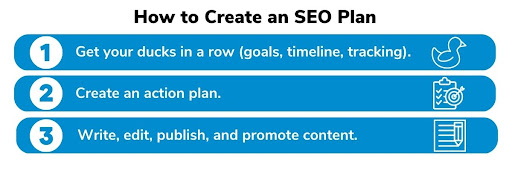How Do You Create an SEO Marketing Strategy?
April 18, 2023 •McKenzi Moorman

If you know anything about marketing, you know that search engine optimization (SEO) plays a major role in landing content in front of prospective customers to generate new leads. Every SEO strategy aims to improve your content, better organize your website, and assist search engines in ranking your website higher. But, with 90% of pages online receiving no organic traffic, it’s clear that creating an SEO strategy of your own can be a tricky process.
Luckily, DemandJump created this blog to help you get started. Once you’re done reading, you’ll have some SEO techniques and tools as well as an SEO marketing strategy example to guide you. Let’s get started!
How Do I Create an SEO Plan?
To create an SEO plan, you need to start by putting all your ducks in a row. That means setting your goals, determining your timeline, and deciding how to track your progress. Make sure that any goals you set in this stage are SMART (Specific, Measurable, Achievable, Relevant, and Timely). It’s okay to dream big, but if those goals aren’t SMART, you’re setting yourself up for disappointment. Creating a 6 month SEO plan can be a good timeframe to start with, although you can lengthen it if need be.
Next, you will need to develop an action plan. Think about how you will go about accomplishing your goals and what tools you’ll need to get there. You’ll also need to decide who will implement the plan and assign each person responsibilities. A big portion of forming an SEO marketing strategy is choosing what content to create. When trying to decide, start by brainstorming what topics your target audiences are most interested in. Which of those topics do you have expertise in? Target those topics. Don’t know where to start? Using a tool like DemandJump can help you pinpoint exactly what subjects to create content for.
Once you have your plan in place, it’s creation time—and editing and publishing time, too. Here’s how we do it at DemandJump. Following Pillar-Based Marketing best practices, we create a network of related content and adhere to a specific internal linking strategy. From there, you simply:
- Edit for clarity as well as spelling and grammatical errors.
- Post several pieces of content within your Pillar Strategy at once to quickly establish your brand’s authority.
- Promote your published content on social media, at conferences, and on partner websites.

What Should Be Included in an SEO Plan?
When you create an SEO plan, make sure to include the four different types of SEO:
- On-page SEO: This encompasses everything on your website. Some key tips to keep in mind as you create content for your website include:
- Use keywords, but don’t overstuff your content. DemandJump’s platform provides you with lists of keywords you can use for any topic you want to write about.
- Avoid duplicate content. It confuses search engines and, frankly, is just plain messy.
- Don’t plagiarize. You’ll get dinged for that by search engines and may even run into some legal issues.
- Off-page SEO: This includes any external factors that direct organic traffic to your website. For example, you might use social media posts or guest blogs on another website to inform readers of who you are and what you offer.
- Technical SEO: This is all that behind-the-scenes stuff that may not be visible but is just as important as the other types of SEO. With this type in mind, your web pages will run faster, look good on mobile devices, and be user-friendly to people of all abilities.
- Local SEO: This promotes your business within your geographic location. You can use keywords in your content related to your location to boost this type of SEO. Keep your Google Business Profile updated so that local traffic can find you easily.
What Makes a Good SEO Strategy?
The most important part of an SEO strategy is putting your target audience at the center of everything you do. That means creating content using language that your audience uses and answering the questions they’re asking. It also means making your website readable and navigable. Google’s 2022 helpful content update rewards pages that cater to human readers and penalizes those that don’t. Yes, you will want to include keywords and all that other jazz to help search engines rank your content. However, your target audience should always come first.

How Do You Write an SEO Content Strategy? With DemandJump!
So now you have the basics down. That’s awesome! Now it’s time for the real work. You have to formulate your SEO strategy. Start with your content. Start with DemandJump. With our platform, you can:
- Create pillar strategies on your chosen topics.
- Find keywords to include within each piece of content.
- See how both you and your competitors are ranking for keywords.
- Learn how to create a Pillar-Based Marketing strategy.
To sign up, you don’t even need to pay!
DemandJump's podcast, Page One or Bust!, discusses in great detail the methodology of Pillar-Based Marketing and how it is shifting the way people think about how to target their ideal customers where they are in their search journey. Check out the below clip from a previous episode, or listen to the full episode at this link.
Featured Articles
Categories
- Attribution Tracking (13)
- Channel Optimization (11)
- Consumer Insights (68)
- Content Marketing (251)
- Data Science (8)
- Digital Marketing (6)
- Digital Transformation (26)
- Enterprise (10)
- Lead Generation (14)
- Market Intelligence (8)
- Marketing Analytics (39)
- Marketing Attribution (57)
- Marketing Management (153)
- Marketing Operations (86)
- Organic Search (222)
- Paid Search (52)
- Pillar-Based Marketing (63)
- Programmatic Advertising (9)
- SaaS Content (14)
- SaaS Marketing (29)
- Search Marketing (111)
- SEO Keyword Research (28)
- SEO Pillar (18)
- SEO Strategy (46)
- SMB (5)
- Website Content (12)


